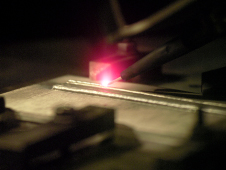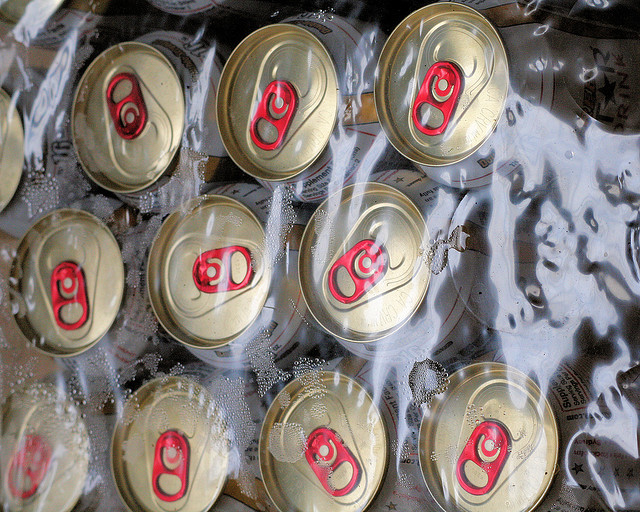Industrial applications
Industrial applications
It is estimated that over 24,000 particle accelerators have been built in the last 60 years for industrial applications. These accelerators are used in either the production or preparation of more than US$500B (390B€) worth of products worldwide annually. Accelerators in various forms are used for a wide range of tasks in the production or preparation of many different end products, ranging from electronics to shrink wrap. The sections below explore in more detail some of the products produced using industrial particle accelerators.
Ion Implantation
Ion implantation for electronics (semi-conductor materials)
Semiconductors are one of the key components of almost all electrical devices from mobile phones to desktop computers. They are materials that conduct a small amount of electricity, more than an insulator but less than a conductor, hence the name. Semiconductors are usually made from silicon - sometimes germanium - that has been doped. Doping is the process of adding impurities to the silicon so that an electric current flows through the material (silicon crystal is an insulator). The doping of silicon is done by a process known as ion implantation. In this process, a beam of ions is fired at a target material. The ions then penetrate, and come to rest within the material at a penetration depth related to the energy of the beam. The development of ion implantation technology leads to better and cheaper semiconductor production, which in turn drives down the cost of electronics and improves the quality of the product.
|
|
Ion implantation for electronics: Many digital electronics rely on ion implanters to build fast transistors and chips. Image credit: Shutterstock.com |
For more information see;
Web (Case Technology): Ion Implanter
Web (The Industrial Physicist [ceased publication]): Ion Implantation in Silicon Technology
Article (Symmetry Magazine) [2013]: Semiconductors
![]() Video: Semiconductors-Ion implantation: 3D Animation
Video: Semiconductors-Ion implantation: 3D Animation
2min28s
Ion implantation for hardening surfaces (metals, ceramics and biomaterials)
In addition to being used in the production of semiconductors, ion implantation can also be used to harden surfaces. When used for surface hardening, the ions of the doping agent material are fired at the target material and only penetrate the material a very short distance, essentially remaining at the surface of the material. Ions are chosen that will complement the atomic structure of the target material, making it stronger. This process is used to create hard surfaces for materials that are used for example in objects like artificial heart valves and other prosthetic implants. (See also section on health and medicine).
For more information see;
Web (azom.com): Surface Hardening by Ion Implantation
Web (Bodycote): Ion Implantation
See also the section on surface hardening using electron beams below.
Electron Beam Material Processing
Electron Beam Welding (EBW)
As the name suggests, electron beam welding (EBW) uses a focused beam of electrons to fuse together two materials. As the beam collides with the metal, the kinetic energy of the electrons is transferred into heat. The heat from the collisions causes the metal to melt and flow together, which joins the two pieces when the molten metal cools. EBW can weld very thin pieces of incompatible alloys with minimal thermal deformations resulting from the process.
|
Space-Age Part Fabrication: A technique developed by NASA, called electron beam freeform fabrication (EBF3) creates small metal parts for spacecraft in a fully automated process involving an electron beam. Image credit: NASA. |
For more information see;
R. Hamm & M. Hamm Eds., Industrial Accelerators and their Applications (Singapore: World Scientific, 2012) ISBN-13 978-981-4307-04-8, p 57-85
Web (Bodycote): Electron Beam Welding
Doc (European Federation for Welding) [2007]: Electron Beam Welding
Electron Beam Machining (EBM)
Electron beam machining (EBM) is similar to EBW insofar as electrons are accelerated to high velocities and focused into a beam. The electron beam is then focused onto a metal, the electrons collide with the metal and the kinetic energy of the electrons is converted to heat. The difference between EBM and EBW is the energy of the electron beam: it is significantly higher in EBM than in EBW so that the metal evaporates, whereas EBW melts the metal. This means that EBM can be used to either, cut, or drill through a metal rather than fuse two pieces of metal. EBM is used to drill holes in the manufacture of air craft engines and nuclear reactor pressure differential devices, and to aid in the etching of microprocessors for the electronics industry.
For more information see;
Lecture (rcsaini.blogspot.com): Electron Beam Machining
Web (engineershandbook.com): Electron Beam Machining
Electron Beam Heat Treating (Surface Hardening)
Certain metal alloys possess a property known as hardenability; this is the amount that the material is hardened after going through a heat treatment process. Heat treatment is an industrial process where the physical properties of a material are altered by the application of an extreme temperature, hot or cold. Electron beam heat-treating is a process, which heats the surface of a hardenable metal alloy up to a certain temperature specific to that material. The material is then cooled quickly which causes the material to harden. The process by which the electron beam heats the metal is the same as for EBW and EBM, the kinetic energy of the electron beam is converted into heat as the electrons collide with the surface. To see how electron beam surface hardening can be used in automobile manufacturing, see the case study: ‘Accelerators for Building a Car’.
For more information see;
R. Hamm & M. Hamm Eds., Industrial Accelerators and their Applications (Singapore: World Scientific, 2012) ISBN-13 978-981-4307-04-8, p 76-78
Doc (Fraunhofer Institute for Surface Engineering and Thin Films): Electron Beam Hardening and Hard Coating for Highly Stressed Tools and Components
J. Davis, Surface Hardening of Steel: Understanding the basics (ASM International, 2002) ISBN: 978-0-87170-764-2, p267-271 [link via google books]
Electron Beam Material Irradiation
Cross-linking polymers
Polymers are molecules made up of a long chain of repeating atomic structures. For example, polyethylene which is the most common form of plastic is a polymer made up of a long chain of carbon atoms bonded together, each with two hydrogen atoms bonded to them.
In the production of shrink wrap, an electron beam is fired at the polyethylene: electrons collide with the polyethylene molecules causing the hydrogen-carbon bonds to break, leaving gaps in the polymer where new atoms can bond to the carbon atoms. Carbon atoms from two separate polyethylene molecules are now free to bond to each other. As carbon-carbon bonds are very strong, this prevents the plastic from melting when heated, the plastic instead shrinks. This process is known as polymer cross-linking and is utilized to create materials used for products like shrink wrap, wire and cable insulation, plastic foam, hydrogels, vulcanized rubber and composite materials used in car and plane manufacture.
|
Shrink Wrap: Shrink wrap packaging is used to package many products and is a common sight in supermarkets, but did you know that particle accelerators play a vital role in its production. Image credit: Vicki & Chuck Rodgers/Flickr |
Hardening materials (X-ray curing of material composites)
Another method of cross-linking polymers is by using X-ray or gamma ray radiation. The decision to use either electron beam or X-ray/gamma-ray treatment is made depending on the type of polymer being cross-linked and the size of the object being treated. Traditionally, curing of materials (curing is the name given to the process of hardening a material by cross-linking polymers) such as vulcanization of car tires and the production of composites (materials made of several different substances) used in car and plane manufacture was done by exposing the ingredients to very high temperatures. The substances were essentially placed in a mold and cooked in a big oven. Curing materials using electrons or X-rays is much quicker than traditional heat curing techniques, greatly increasing the throughput of factories producing composite car and plane parts in addition to producing materials with more favorable properties than the traditional method.
|
|
Hardening materials: Replacing steel with X-ray cured carbon composites can reduce car energy consumption by 50%. Image credit: INFN/ Domenico Santonocito, Italy |
For more information see;
Article (Symmetry Magazine) [2010]: Heat-shrink tubing, A wiry protector
Article (Symmetry Magazine) [2009]: An electron zap turns flimsy plastic into sturdy shrink wrap
Doc (UDRI): Curing and Bonding of Composites Using Electron Beam Processing
Web (about.com): Electron Beam Curing
Article (Sterigenics) [2010]: Radiation Crosslinking of Polymers
See also the case study: Accelerators for building a car
Treating waste and medical materials
Beams of electrons fired from small particle accelerators are used in factories that produce medical apparatus to sterilize them. The beam of electrons kills any microbes without damaging the equipment or the packaging, an advantage this method holds over other sterilization techniques.
For more information see;
Article [2010] (Symmetry Magazine): Sterilizing Medical Supplies
Web (IBA Sterilization): E-Beam Sterilization for Medical Devices
Food preservation
The same process is used for food preservation. However for irradiation of food items, it is essential to select a dose high enough to kill or prevent the bacteria or insect from reproducing, and low enough that it does not damage the food. Many food products are treated using an electron beam: fruit and vegetables, cereals, spices, fish, fresh meats…
|
Many foods such as fruits and vegetables are treated using electron beams to help keep them fresher for longer. Image credit: World Bank Photo Collection/Flickr |
For more information see;
Doc [2006] (Food Irradiation Processing Alliance): Food irradiation: Questions and answers
Web (European Commission): European legislation on food irradiation
Article [2011] (Symmetry Magazine): Food Packaging: Clean, Green Containers for Food and Drink





